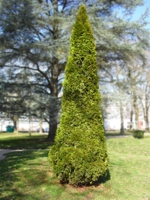Mon-Fri 9am - 5pm Mountain time
Emerald Cedar vs Medora Juniper
Thuja occidentalis Smaragd
Juniperus scopulorum Medora
NOT AVAILABLE THIS SEASON - MIGHT RETURN
NOT AVAILABLE THIS SEASON - MIGHT RETURN
Emerald Cedar makes a great addition to landscapes, and is often used to form tight hedges or privacy screens. The thick scale-like foliage adds texture and colour to yards and is commonly used to line driveways. Unlike other cedars it retains its green colour throughout the fall and winter.
It is a semi dwarf species, which generally needs little pruning, but if desired it responds well to trimming. Its attractive, columnar shape and dense foliage makes it a desired landscape feature.
The Emerald Cedar won the award of merit from the Royal Horticultural Society.
Medora Juniper has an upright, narrow growth habit that makes it well suited as either an accent shrub or as a privacy hedge or screen. It is a compact, pyramidal evergreen shrub with blue-green foliage that lasts year round.
It is low maintenance, drought tolerant, and deer resistant. Medora Juniper is known for holding its form well without pruning. If pruning is desired it is best done in late winter after the threat of extreme cold has passed.

